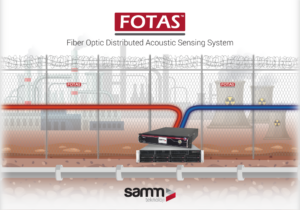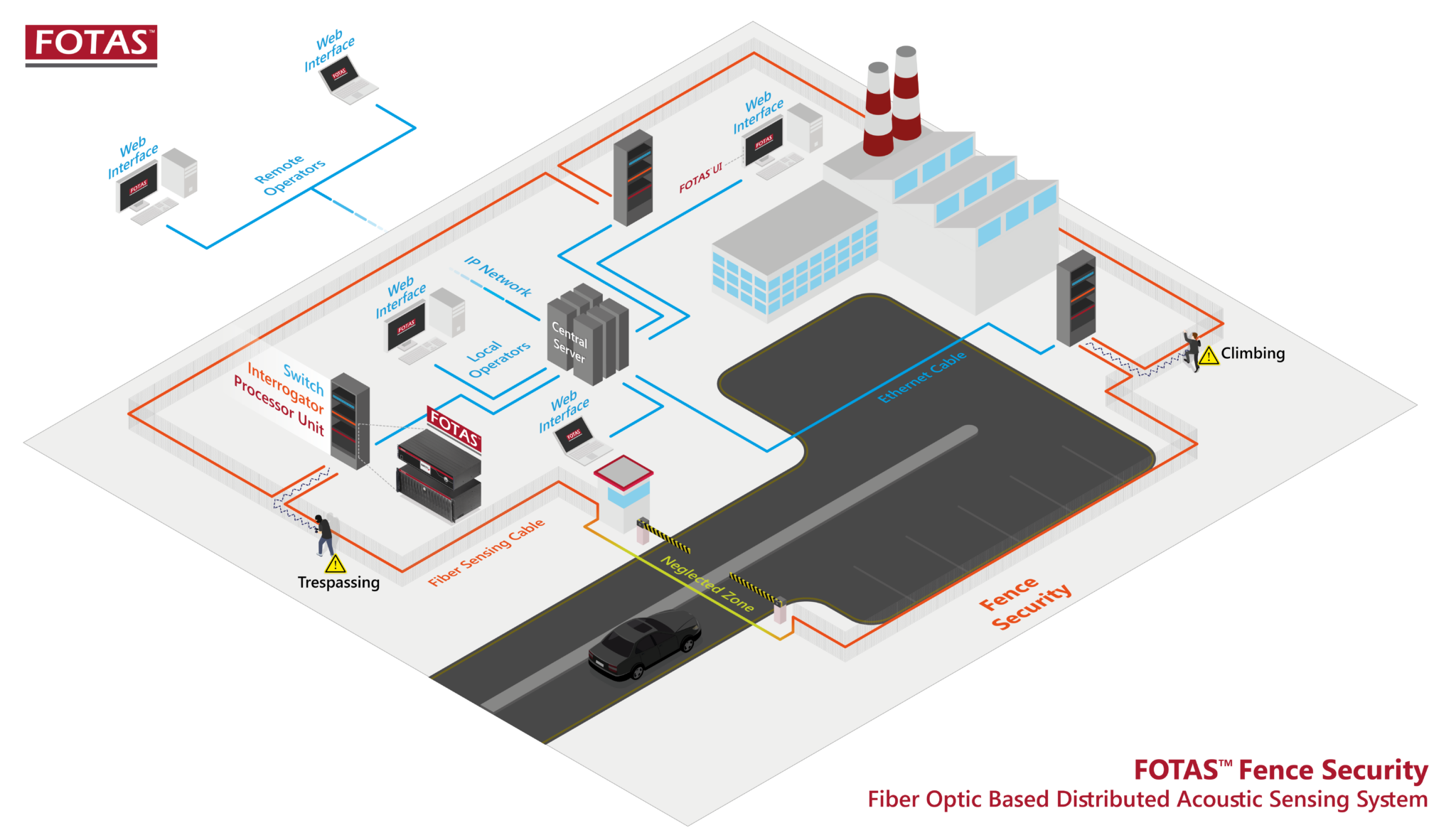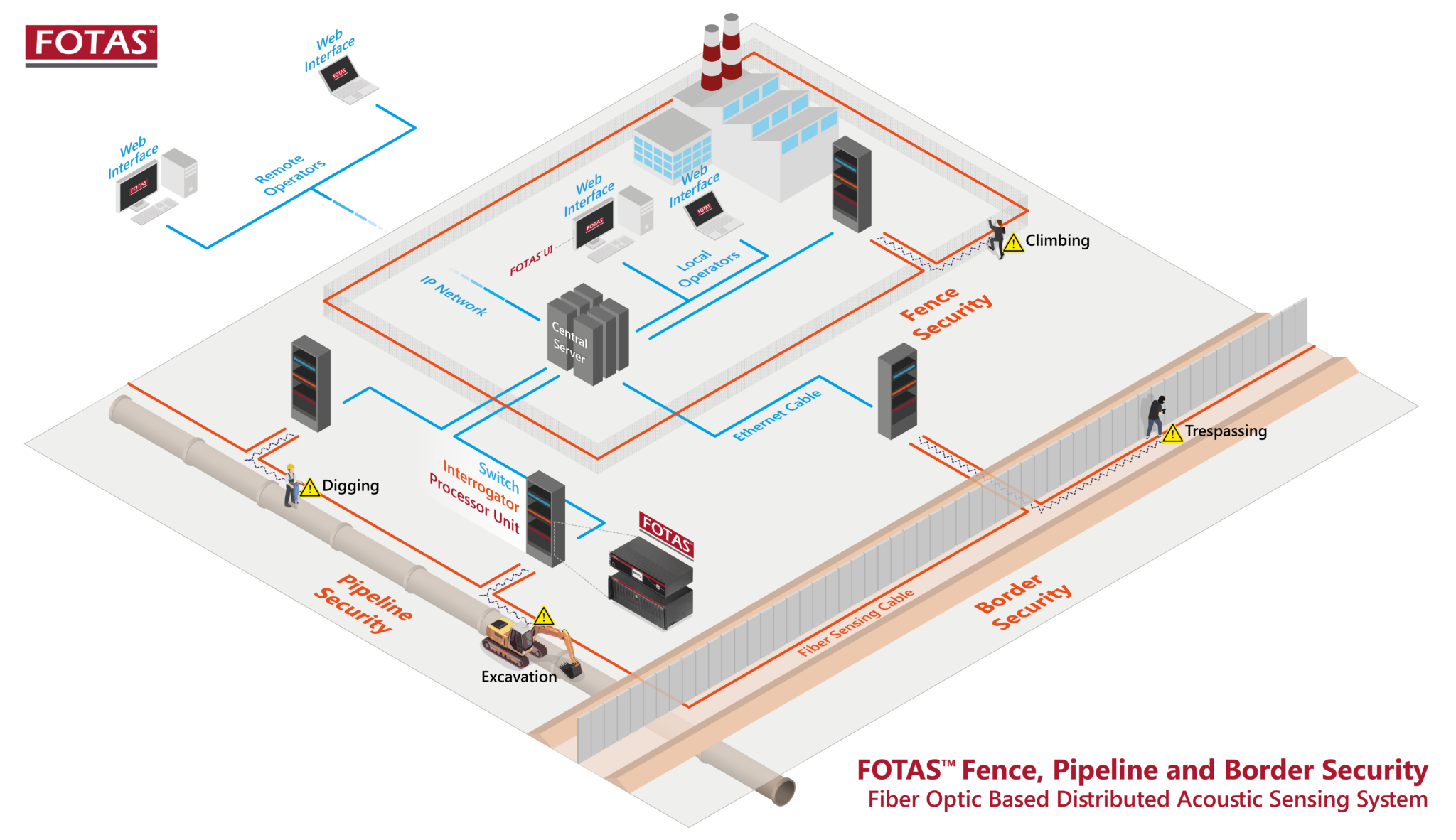
FOTAS is a cutting-edge distributed acoustic sensing (DAS) solution developed by SAMM Teknoloji. By transforming standard fiber optic cables into highly sensitive, real-time vibration sensors, FOTAS delivers unmatched detection precision and reliability across vast distances. Engineered with advanced signal processing and AI-driven classification, it stands out as one of the most powerful and adaptable DAS platforms available on the market today.
The open form of FOTAS is “fiber optik tabanlı dağıtık akustik sensör” or “fiber optics based distributed acoustic sensor” in English.
FOTAS is developed by SAMM Technology engineers and software developers, so it is a local product.
FOTAS sends laser pulses into a single-mode fiber optic cable and analyzes the Rayleigh
backscattering signal. Vibrations or acoustic disturbances cause changes in the backscatter
pattern, which are detected, localized, and classified using machine learning-based
algorithms.
The first part is the interrogator unit, which analyzes the reflected light’s amplitudes and
shifts in light signals. The second part is the processing unit, where artificial intelligence
processes the data gathered by the interrogator unit. This unit also hosts the user interface
for system management. The third part is the fiber optic sensing cable, which can be
connected to the interrogator unit from one or both ends, enabling flexible deployment and
enhanced fault tolerance.
The interrogator unit and processing unit are each 2U (2 rack units), which refers to a
standard measurement of rack space, with each “U” representing 1.75 inches in height. This
compact design ensures efficient operation while providing flexibility in deployment and
scalability
FOTAS uses standard fiber optic cables as the sensing medium. These cables consist of a
core, typically made of transparent glass or plastic, surrounded by cladding with a lower
refractive index. This design keeps light confined within the core through total internal
reflection, enabling long-distance signal transmission with minimal loss. When vibrations or
disturbances occur, they cause changes in the backscattered light pattern. FOTAS analyzes
these variations with advanced signal processing algorithms to detect, locate, and classify
potential anomalies or threats along the cable path in real time.
Fiber means a thread or filament from which a vegetable tissue, mineral substance, or textile is formed; but here these threads are formed by very thin glass so that the light can travel in it. These glass threads are so thin that they can be wrapped together to form multi-channel cables.
Optical fiber is a type of cable that is made up of thin strands of glass or plastic that are used to transmit information over long distances using light. The fiber optic cable consists of a core, which is where the light travels through, and a cladding, which is a layer of material that surrounds the core and helps to keep the light in the core. The cable may also have a protective outer layer called a jacket.
Optics is the branch of physics that investigates the light itself. It searches the answers to the questions like “How does the light behave in different mediums?” or “What can we use the light for?”.
Optical fibers are used to transmit information in the form of light signals over long distances with very little loss of signal strength, making them a preferred choice for telecommunications networks, internet connections, and cable television. They are also used in medical equipment, military communication, and scientific research. Compared to traditional copper cables, fiber optic cables can transmit much more data over longer distances and are more resistant to interference from electromagnetic fields.
Fiber optic is the cable in which the light travels. These cables are made of very thin glass and unlike the traditional cables which carry electricity; they carry light itself. It seems like there isn’t much difference between them but the working principles are different. In the traditional cable, the carrier is electron whereas in fiber optic cable, the carrier is photon. Because the carrier is photon; data transfer is at the speed of light.
Acoustic sensing is a technology that detects and measures physical properties and events by using sound waves. Its fundamental principle is based on the propagation of sound through different mediums—such as solids, liquids, and gases—and its ability to reflect changes within these environments. This technology provides valuable information across a wide range of fields, including healthcare, environmental monitoring, security, sonar, and the detection of structural defects in materials.
Distributed Acoustic Sensing (DAS) is a technology that transforms standard fiber optic cables into sensitive sensors along their entire length. Unlike point sensing, it detects sound waves and vibrations across the whole cable line. Thanks to its high sensitivity and localization capabilities, it offers a flexible and cost-effective solution for monitoring large areas using existing fiber infrastructure.
FOTAS distributed acoustic sensing system can be used anywhere where it is meaningful to
gather data from the environment. We could use it in energy, oil and gas industry to watch
the pipes for maintenance or to detect leaks and accidents.
In the same vein, we could use it to monitor the situation of the traffic from the already
installed fiber optic network and with that we could learn where the traffic is jammed and
how bad it is, if there is an accident on the road and where etc. We could also use FOTAS to
monitor the underwater power and information cables. Seismic activity could also be
watched with FOTAS and with this we can gather more information about earthquakes and
volcanic activity. Perimeter security is another area where FOTAS could be used. If it is
installed on the fence it can detect climbing on the fence, cutting and splitting of the fence
and can distinguish these situations from each other. If it is buried around a structure, it can
detect the activity in the environment and could alert the user by giving the type of threat.
The four main areas are;
• Oil & gas pipelines (e.g., for TPI detection and leak detection)
• Border and perimeter security
• Railway and power transmission corridors
• Urban critical infrastructure (e.g., data centers, telecom)
FOTAS acoustic sensor could be used in places where instead of using sensors with electromagnetic waves, fiber optic sensors preferred. However; in the industry the fiber optic usage usage is generally consists of traffic control; petrol, oil and gas leak detection, the monitoring of underwater cables, the structural control of the buildings and big structures, perimeter security and detecting the seismic activity.
Yes. FOTAS can operate on standard single-mode fiber optic cables, including dark fibers and unused fibers within communication cables, provided the fiber meets basic installation standards.
FOTAS can typically monitor up to 50 km per channel (100 km in total using both directions), depending on fiber quality and installation conditions. Range can be extended using repeater stations or multiple interrogator units.
FOTAS offers high detection performance, with location accuracy typically within ±10 meters. Depending on the FOTAS model and fiber installation quality, accuracy can improve down to 4 meters. Event classification accuracy exceeds 90% under calibrated conditions, enabling reliable differentiation between various types of intrusions and environmental activities.
FOTAS uses advanced signal processing and AI-based classification algorithms trained on various event signatures to distinguish between different types of acoustic events such as walking, digging, or vehicle movement.
You won’t need additional sensors or electrical sensor components since FOTAS system uses a whole fiber optic cable as an acoustic sensor. Only one FOTAS box installed in the system room and its fiber optic cable is enough to know what is going on in the environment. Other point sensors need an additional power supply at the point they are installed whereas FOTAS doesn’t. Normally perimeters or pipe networks are watched by humans or systems which need continuous power; but with fiber optic sensing we don’t need such time and money consuming methods anymore. Another advantage of fiber optics is that they are very lightweight and also they don’t need an additional monitoring once they are installed.
You can use the FOTAS acoustic sensing system wherever you want, 24/7, for continuous data streaming without additional manpower and power supply. Once installed, it can be used for 20 years and additionally has no damage to the environment.
FOTAS does not rely on cameras for monitoring; instead, it uses long fiber optic cables to
detect anomalies through acoustic sensing. However, the system is fully compatible with
external cameras, drones, or other visual systems, allowing users to integrate real-time
video feeds for enhanced situational awareness and verification when needed.
FOTAS supports integration via REST API, Modbus TCP, SNMP, OPC-UA, http and Syslog. It can be easily integrated with third-party SCADA, DCS, or PSIM platforms.
While FOTAS is primarily optimized for intrusion and vibration detection, it can also detect leaks independently by sensing acoustic disturbances caused by high-pressure gas or fluid releases. Its advanced signal processing capabilities allow it to identify potential leak events without the need to pair with additional sensing technologies like DTS or DFOS.
If the fiber infrastructure is already in place, a FOTAS unit can be commissioned and calibrated within 2 to 5 days per site, including testing and training.
Yes. FOTAS adheres to relevant IEC, ISO/IEC, and cybersecurity standards. It is designed to meet oil & gas industry guidelines and NATO border surveillance requirements, depending on the use case.
FOTAS requires minimal maintenance, primarily software updates, health checks, and optional recalibration. Fiber health should be monitored periodically.
Yes. FOTAS is built with rugged, industrial-grade hardware housed in IP-rated enclosures,
making it suitable for deployment in challenging environments such as deserts, mountainous
terrain, coastal areas, and remote infrastructure sites. It is designed to perform reliably under
dust, moisture, and other environmental stresses commonly encountered in the field.
Compared to other systems, FOTAS acoustic sensing system doesn’t need much power and additional monitoring system, and it could be used at least 20 years with continuous data flow means that it is the much cheaper and effective system.
No, the acoustic sensing ability of the FOTAS system does not get affected by environmental conditions. The FOTAS acoustic sensing interrogator and processing unit are kept in a safe system room. On the other hand, the sensing fiber optic cable has a firm coating and it is buried underground so it isn’t affected from the environmental conditions. With this, we have an effective system which is able to work in harsh environments. It can also be used to watch underwater cables because of this ability.
Not yet. Theoretically, FOTAS acoustic sensing system should be able to detect early earthquake vibrations. However, the ongoing R&D project for this subject is not yet finished. SAMM Technology R&D department have been doing studies about this subject for two years. When enough data is gathered and analysed, the results will be shared publicly and this function might be implemented into the system.
If the acoustic sensing fiber is cut, FOTAS immediately detects the disruption and alerts the
user through its intelligent monitoring interface. The system continues to operate normally
up to the point of the cut, maintaining sensing capabilities on the intact section of the cable.
When the fiber is connected from both ends (loop configuration), a single cut does not
interrupt the overall sensing coverage. In such configurations, only two separate cuts at
distant points would create an isolated blind spot, ensuring high fault tolerance and system
resilience.



